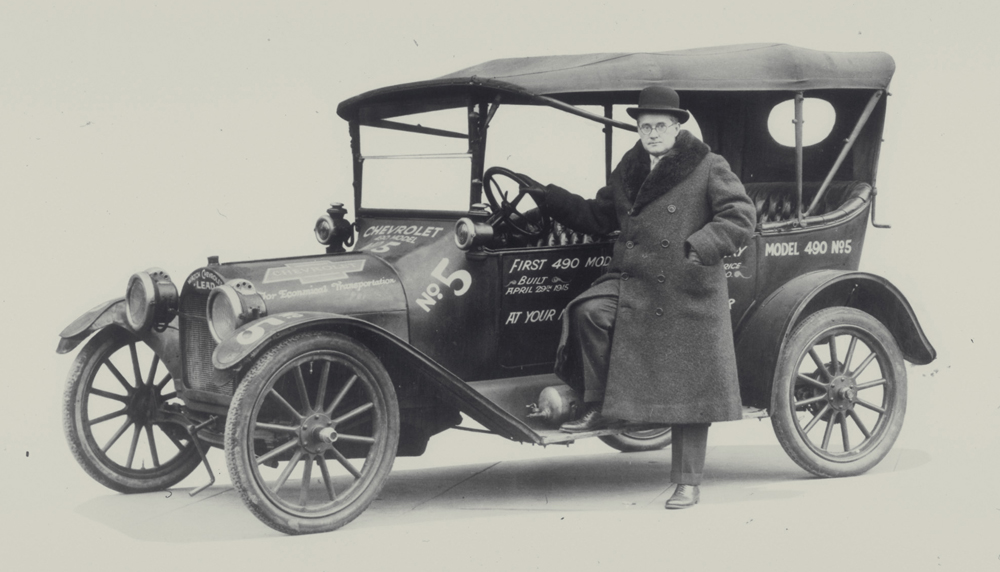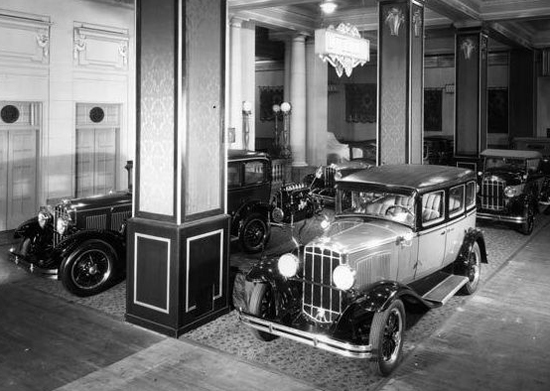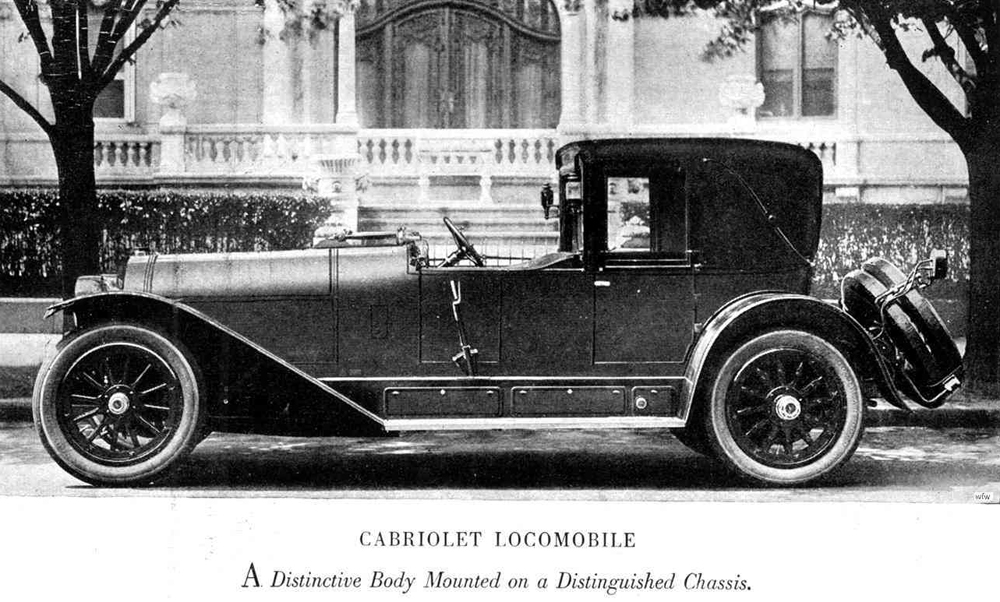
William Crapo “Billy” Durant (December 8, 1861 – March 18, 1947)
General Motors was founded by William “Billy” Durant on September 16, 1908. Durant had become a leading manufacturer of horse-drawn vehicles in Flint, MI before making his foray into the automobile industry.
Born in Boston, Massachusetts on Dec. 8, 1861, Durant was the grandson of Michigan governor Henry H. Crapo. In 1886, he founded the Flint Road Cart Company, eventually transforming $2,000 in start-up capital into a $2 million business. By 1890 the Durant-Dort Carriage Company, based in Flint, Michigan, had become a leading manufacturer of horse-drawn vehicles. Durant also conceived the modern system of automobile dealer franchises.
By 1900, there was significant public outcry for government regulation of gas-powered horseless carriages. Durant heard this outcry, and rather than relying on government regulations to improve their safety, saw an opportunity to build a successful company by improving on the safety of these new machines. In order to accomplish this, he sought out the purchase of Buick, a local car company with few sales and large debts.
When approached to become General Manager of Buick in 1904, he made a similar success and was soon president of the company. Durant acquired control of the Buick Motor Car Company and by 1908 Buick was one of the four leading automobile companies. Durant had a vision of the boundless possibilities of the automobile, particularly the moderate-priced car, and attempted to capitalize on these possibilities by establishing a large-scale enterprise based on volume production. He intended that his company would be well financed, market a variety of automobiles, and produce many of its own parts.
The enigmatic Durant was an interesting character. His biographers portray him as a magnetic industrialist in the spirit of the early 20th century. Both charming and smart, Durant was boundlessly enthusiastic and endlessly open to new business ventures. Walter P. Chrysler once said of Durant’s legendary magnetism that he could charm a bird off a tree.
Durant was intrigued not only by Chevrolet’s performance as a race-car driver. Louis’ fine French-sounding family name sang of marketability to the entrepreneur. When the irrepressible Durant was ousted from GM in the midst of a 1910 financial crisis, he set out to re-enter the auto industry without missing a beat. Soon, he had an arrangement with Louis Chevrolet to build a car bearing the well-known racer’s name. Just as in 1904, when Durant had stepped into the driver’s seat of David Dunbar Buick’s ailing auto company, the industrialist secured rights to the brand name that came with the agreement. On November 3, 1911, the Chevrolet Motor Car Company was incorporated.

One year after the Chevrolet Motor Car Company was established, the first car to bear his name—a thoroughly contemporary, powerful and luxurious car—rolled out of a pilot factory in Detroit. This $2,100 Chevrolet was introduced as the Type C Six for 1913.
Durant’s plan for the Chevrolet automobile differed from that of his partner. He envisioned the Chevrolet brand on an inexpensive car that would offer significantly more value than the volume leader of the period, while selling for only a bit more money. The four-cylinder “Royal Mail” roadster and “Baby Grand” touring car models Durant introduced at $750 and $875 respectively in mid-1913 set Chevrolet on the road to achieving this goal. In late 1913, Durant introduced his $490 Chevrolet 490 for 1916 into the low-priced car market.
Louis Chevrolet felt his influence slipping away, and perhaps the legendary ‘cigar/cigarette argument’ between him and Durant that abruptly ended their partnership was inevitable.
Before 1915 was out, Durant leveraged the strength of his Chevrolet company stock to effectively retake control of General Motors. In 1918, Durant officially merged Chevrolet into GM. However, the ebullient empire builder would lose control of GM yet again in 1920…leaving it to others to build the Chevrolet brand into the auto industry leader he’d intuitively sensed it could become.
In 1919 General Motors was one of the largest American industrial enterprises, but Durant exercised little control over its operation; General Motors was too decentralized to be effective. When the Panic of 1920 occurred, Durant was overcommitted in the stock market. He tried unsuccessfully to support the price of General Motors stock; he was forced out of the company in 1920.
Durant was a pioneer in the automotive industry, and his most notable creation, General Motors, has dominated the automobile market since. Some of his chance ideas, such as the entry of General Motors into the manufacture of refrigerators, were highly successful. However, Durant never succeeded in organizing and administrative structure adequate for the giant enterprise he founded, and the task of converting General Motors into an enduring monument was left to his successors.
Billy Durant had lost control over General Motors in the course of the 1920’s depression. His company and personal finances were ruined. He used to say: “Money? What is money? It’s only a passing pleasure. Human beings are born with nothing, and they leave this world with nothing.” Thanks to this attitude he regained courage and reactivated his business acumen and founded “Durant Motors”.
William “Billy” Durant died in New York City on March 18, 1947. nearly broke at age 85.
 Durant Motors
Durant Motors
Durant Motors Inc. was established in 1921 by former General Motors CEO William “Billy” Durant following his termination by the GM board of directors and the New York bankers that financed GM.
Durant Motors attempted to be a full-line automobile producer of cars and fielded the Flint, Durant, and Star brands which were designed to meet Buick, Oldsmobile, Oakland and Chevrolet price points. Billy Durant also acquired luxury car maker Locomobile of Bridgeport, Connecticut, at its liquidation sale in 1922; in theory Locomobile gave him a product that would compete against Rolls Royce and Pierce-Arrow. Durant Motors had a relationship with the Dort, Frontenac and DeVaux automobile name badges. The Rugby line was the export name for Durant’s Star Car line. However, from 1928 to 1931 Durant marketed trucks in the US and Canadian markets under the badge Rugby Trucks. The Princeton, a model aimed at the Packard and Cadillac price point was planned, but never realized; also planned was the Eagle car line but it never made it off the drafting tables.
Durant co-founded a truck-making subsidiary, Mason Truck, and also acquired numerous ancillary companies to support Durant Motors. In 1927 the Durant line was shut down to retool for a brand new modernised car for 1928, re-emerging in 1928 with Durant, Locomobile and Rugby lines in place, and dropping the Mason Truck and Flint automobile lines and top-selling Star car in April 1928. In 1929 Locomobile went out of production.
Initially, Durant Motors enjoyed success based upon Billy Durant’s track record at General Motors where he assembled independent makes Chevrolet, Oakland, Oldsmobile, Buick and Cadillac. However when sales failed to meet volumes sufficient to sustain Durant Motors holdings, the firm’s financial footing began to slip. As a result, Durant Motors began losing market share and dealers. The final models, produced under the Durant brand, rolled off the assembly line in 1931 but continued in Canada as Durant Frontenac.
The Lansing, Michigan, Durant plant on Verlinden Avenue opened in 1920. After the demise of Durant, it remained closed until GM purchased it in 1935. It restarted production for GM’s Fisher Body division, later becoming the Buick-Oldsmobile-Cadillac factory. It was finally combined with another Lansing plant to become Lansing Car Assembly. That factory was closed on May 6, 2005.




You must be logged in to post a comment.